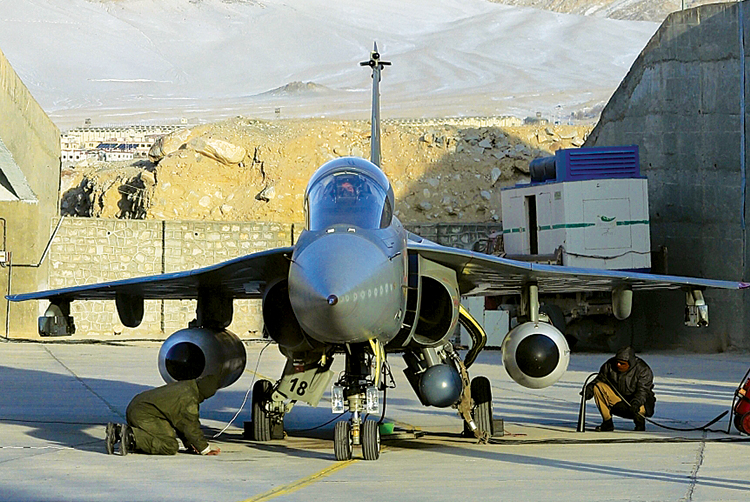INDIAN ARMED FORCES CHIEFS ON OUR RELENTLESS AND FOCUSED PUBLISHING EFFORTS

The insightful articles, inspiring narrations and analytical perspectives presented by the Editorial Team, establish an alluring connect with the reader. My compliments and best wishes to SP Guide Publications.

"Over the past 60 years, the growth of SP Guide Publications has mirrored the rising stature of Indian Navy. Its well-researched and informative magazines on Defence and Aerospace sector have served to shape an educated opinion of our military personnel, policy makers and the public alike. I wish SP's Publication team continued success, fair winds and following seas in all future endeavour!"

Since, its inception in 1964, SP Guide Publications has consistently demonstrated commitment to high-quality journalism in the aerospace and defence sectors, earning a well-deserved reputation as Asia's largest media house in this domain. I wish SP Guide Publications continued success in its pursuit of excellence.
Needs to be Truly Potent
Unless the Tejas is developed into a truly capable platform, it will not be able to provide the operational edge that the combat fleet of the IAF badly needs

While the fleet of combat aircraft in the Indian Air Force (IAF) is dwindling rapidly, the indigenous light combat aircraft Tejas has been somewhat slow in coming. Media reports in the recent past indicate that the IAF is proceeding with the acquisition of 83 Tejas Mk IA, the advanced version of the Tejas Mk I worth 60,000 crore. This project was cleared in November 2017 by the Defence Acquisition Council headed by the Minister of Defence.
Having obtained Initial Operational Clearance (IOC) two years ago, HAL is now aiming for the Final Operational Clearance (FOC) for the Tejas by the end of 2018. Despite the fact that the LCA Tejas is yet to be fully operational, the IAF has ordered 20 of the Tejas Mk I in IOC configuration. The IAF will induct the next 20 aircraft after the Tejas achieves FOC, bringing the total to 40. HAL had plans to develop the Tejas Mk II version that is to be fitted with the GE F414 engine, with higher thrust rating as compared to the GE F404 that powers the Mk I. However, in view of the inordinately long time frame anticipated for its development as the airframe of the LCA Mk II would involve considerable redesign thus making it practically a new aircraft, the IAF was understandably reluctant to wait that long. The Ministry of Defence therefore suggested an advanced version of the LCA Mk I, the Mk IA with a number of improvements especially in avionics. These inductions totalling to 123, equivalent of around six squadrons, will help the IAF to fill, albeit only partly, the ever widening gap in the combat fleet of the IAF.
Currently, the rate of production of the LCA Tejas is eight air craft per year. At this rate it will take around 15 years to complete delivery against the initial order for 123 aircraft. HAL plans to set up a second production line to double the rate of production. However, the time frame for the establishment of the second production line has not been specified, injecting a degree of uncertainty in the future of the Tejas programme.
Meanwhile, the Indian aerospace major has been embarked on a public relations exercise to showcase the Tejas not only domestically, but in the international arena as well. The aircraft was showcased at the Bahrain International Air Show in January 2016. As reported by the Indian aerospace major, the LCA Tejas “stunned the viewers with a performance that lasted just under 10 minutes”. There were enquiries regarding the aircraft from possible customers from the South Asian Region. On the domestic front, in the recent years, there have been a stream of senior functionaries from the IAF as also civilian dignitaries including one from abroad who have been flown in the trainer version. The first senior officer of the IAF to fly the Tejas was Air Marshal S.B.P. Sinha, the Deputy Chief of Air Staff (DCAS) at Air HQ. While on a visit to the Aeronautical Development Agency on September 3, 2014, the DCAS got airborne in the Tejas becoming the first senior officer from Air HQ to do so. For the Indian aerospace industry, this flight of Tejas by a senior IAF officer was an indication of the high degree of confidence in the indigenous product. On May 15, 2016, Air Chief Marshal Arup Raha, Chief of the Air Staff, IAF, flew a 30-minute sortie and carried out simulated air-to-air and air-toground attacks using different modes of the advanced Israeli made radar and the helmet mounted targeting system on the aircraft. In February 2017, during a visit to Aero India Air Show at Air Force Station, Yelahanka, his successor, Air Chief Marshal B.S. Dhanoa, Chief of the Air Staff, flew a sortie on the Tejas. Towards the end of the year on November 14, 2017, Air Marshal R.K.S. Bhadauria, Air Officer Commanding in Chief, Southern Command of the IAF, flew a 30-minute solo mission on the indigenous fighter aircraft. The Air Marshal has been an experimental test pilot and has flown over 100 test flight missions on the Tejas during his younger days. But perhaps the most glamorous event was the flight by Ng Eng Hen, Minister of Defence, Singapore, who was the first foreign dignitary to fly the Tejas. As expected, he was full of praise for the aircraft. While the public relations exercise has certainly helped boost the image of the Tejas, unless it is developed into a truly capable platform, it will not be able to provide the operational edge that the combat fleet of the IAF badly needs.





